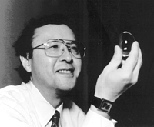CAMBRIDGE, Mass.- Massachusetts Institute of Technology Physics Professor Toyoichi Tanaka, a world leader recognized for his revolutionary discovery of "smart" gels, the phase transition in polymer gels, died of heart failure on Saturday, May 20, while playing tennis. He was 54.
The wake will be on Wednesday, May 24, from 4-8 PM, at the George F. Doherty & Sons Funeral Home, 477 Washington Street, in Wellesley. A memorial service will be held on Thursday the 25th, 10:30 AM at the Wellesley Hills Congregational Church, 207 Washington Street, Wellesley, MA (at the intersection of Rt. 16 and Rt. 9).
"Professor Tanaka's pathbreaking work on gels exemplifies the spirit of innovation and the interaction between fundamental scientific curiosity and practical applications that is so important at MIT. He will be deeply missed by colleagues here and around the world," said MIT President Charles M. Vest.
"Toyo was a great physicist and a superb teacher," said Marc Kastner, head of the MIT Department of Physics. "His demonstrations of the miraculous properties of gels were spellbinding and showed young and old that even commonplace materials can behave in wondrous ways. He was a personal friend and I will miss him greatly."
Professor Tanaka was the inaugural holder of the Otto and Jane Morningstar Professorship of Science in the Department of Physics and a Principal Investigator at the Center for Materials Science and Engineering. His pioneering research on "smart" gels lead to applications ranging from cleaning up pollutants and releasing pharmaceuticals in the body to finding the origins of life on earth.
SMART GELS
"Smart" gels are a class of materials that expand or contract when triggered by tiny changes in temperature, light, a solvent, or other stimulus. The ability of the gels to undergo huge but reversible changes in volume allows unique new systems to be made that can encapsulate and release materials. Gels can be engineered to clean up pollutants or oil spills. Even in cosmetics, gels could hold and then release key ingredients like fragrance in response to factors like skin pH. Gels can be used as soft valves or act as artificial muscles.
"That's the beauty of it," Professor Tanaka once said. "Depending on what a gel interacts with, it will have different behaviors."
A gel is a polymer, a long chain of monomers, or molecules, that are cross-linked like a web of fibers. It is those links, which allow a gel to capture water within them, that give gels their elasticity and fluidity. The fundamental principles that govern the swelling equilibrium and dynamics also turned out to be a powerful paradigm for understanding the molecular basis of polymer behaviors in general. Professor Tanaka was exploring the idea that gels may provide a clue to the baffling puzzle of how life on Earth began.
"By understanding the phase transitions of gels, we can better understand protein functions, the molecular basis of life," he said. Life boils down to amino acids. Made up of different sequences of 20 amino acids, proteins twist into shapes that they "remember;" they recognize certain molecules and can store and release them as necessary; they help life-sustaining chemical reactions take place. They line up in chains called polymers. Scientists can determine the sequence of amino acids that make up specific proteins, but they don't know how to make one from scratch.
Professor Tanaka's laboratory is working on synthesizing a gel with characteristics similar to those of proteins capable of recognizing a target molecule. What's more, this can be done without specifying the gene sequences to "build" the protein artificially.
"This may be a crude model of 'prebiotic polymerization,' which is a key step in the origin of life and prebiotic evolution," he said. "Some sort of prearrangement of the individual amino acid or nucleotide molecules that join together in a certain shape and sequence to make the polymer, possibly in the presence of some target molecule, can be easily imagined to exist in the primordial soup," he said.
The current theory holds that back in the Earth's early days, amino acids swimming around in a primordial soup randomly came together in a viable sequence. This theory didn't hold much water with Professor Tanaka. For one thing, he said, there hasn't been enough time since the beginning of the universe to try all the possible combinations. With 20 existing amino acids and 400 possible working sequences, that is a mind-boggling number.
"There is no way that amino acids happened upon the one particular sequence for a protein such as hemoglobin by accident," he said.
Professor Tanaka was born in Nagaoka-city, Niigata Prefecture, Japan in 1946. He received his BS (1968), his MS (1970) and his DSc (1973) in physics from the University of Tokyo. He joined the MIT physics faculty in 1975 after working for the department as a sponsored research staff member. He married Tomoko Tahira in 1970.
In 1992, Professor Tanaka co-founded GelMed Inc., a Bedford, Mass. company. GelMed and its sister company, Gel Sciences Inc., explore medical, cosmetic, commercial and industrial applications for gels. More recently, he co-founded Buyo-Buyo, Inc. to bring to fruition medical solutions that would enhance and extend our lives.
AWARDS AND HONORS
Professor Tanaka was the winner of the 38th Toray Science and Technology Prize from the Toray Science Foundation in Japan and the 1994 Inoue Prize for Science, awarded for outstanding achievements in basic sciences in general and given each year to a scientist under age 50. He was awarded the Vinci d'Excellence in France for his work in 1993. His other honors include The Award of the Polymer Society of Japan in 1986 and the Nishina Memorial Prize in 1985. He also received an R&D 100 Award and a Discover Award from Discover magazine. He became a fellow of the American Physical Society in 1992.
Professor Tanaka is survived by his wife, Tomoko; his parents, Toyosuke and Shizu; a son, Kazunori, a physics graduate student at MIT; a daughter, Ayako; and a sister, Noriko.
In lieu of flowers, gifts may be sent to the Toyoichi Tanaka Memorial Fund, C/O Isabel Cunha-Vasconcelos, Department of Physics, Massachusetts Institute of Technology, 77 Massachusetts Avenue, Room 6-107, Cambridge, MA 02139.







